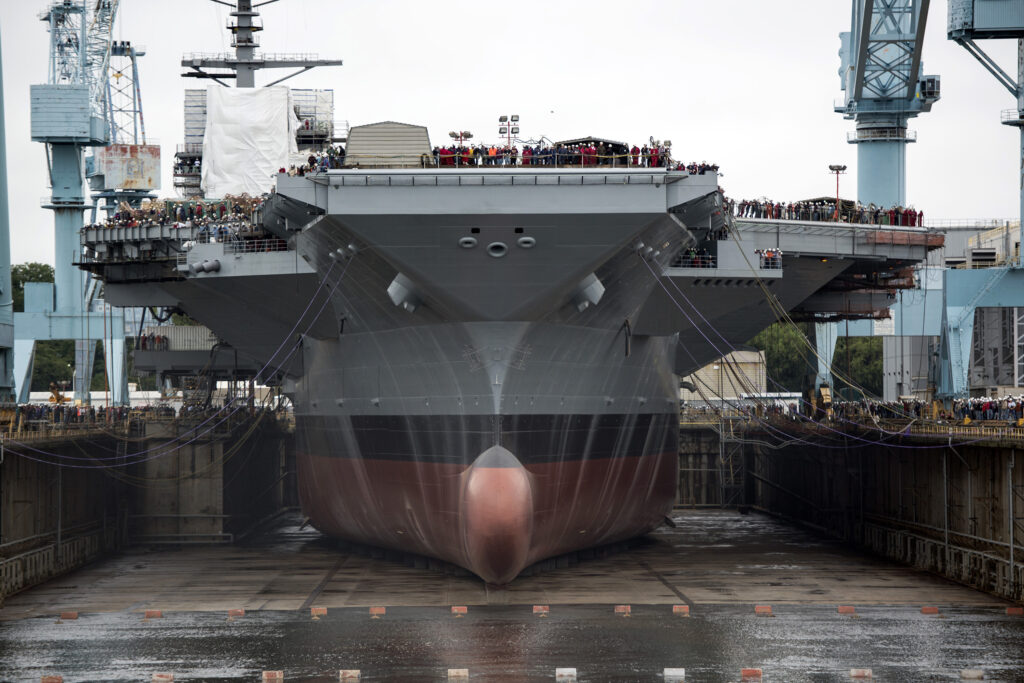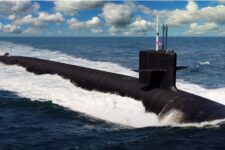
Newport News Shipbuilding prepares to float the USS Gerald R. Ford
WASHINGTON: A top lawmaker expressed deep frustration with the details and timing of a new White House shipbuilding plan released today, a project which would add tens of billions to the Navy’s budget in the coming years to build dozens of new ships.
The 30-year shipbuilding plan, which was due in February but placed on hold until today, would cost $147 billion between 2022 and 2026, a sharp increase from the $102 billion the Navy had projected earlier this year. The plan was publicly released by Deputy Defense Secretary David Norquist and previewed Wednesday by National Security Advisor Robert O’Brien in an op-ed in the Wall Street Journal.
As of late afternoon, neither the Secretary of the Navy or the service’s top admiral comments on the new plan, an indication that the White House and Pentagon are leading the charge and the Navy is taking a back seat.
“Our Navy is very appreciative of the interest leadership has taken in the Navy’s ship building plan and you will see Navy officials commenting on this important plan in the coming days and weeks,” Navy spokesman Capt. Danny Hernandez told me.
The timing of the report’s release — in the Trump administration’s lame duck period — will likely put some pressure on the Biden team to publicly accept or reject it right out of the gate. That may provide Republican lawmakers with grist to criticize the Biden Pentagon if the proposal is scaled back or rejected.
The plan’s arrival frustrated the influential chairman of the House seapower and projection forces subcommittee, Rep. Joe Courtney, who told me today he first heard it was being released Wednesday evening when National Security Advisor Robert O’Brien outlined the effort in a Wall Street Journal op-ed.
Courtney, a staunch advocate for a larger Navy who represents a Connecticut district that’s home to submarine builder Electric Boat, said the major changes stand in opposition to four years of Trump administration budgeting.
“The galling part of this is that we had a 2021 budget [from the White House] that cut Navy shipbuilding by 17%,” only to have the administration turn around months later with a massive new request, Courtney said.
He rejected the idea that the new administration might find itself boxed in by the huge proposed investments “The contradictions and the flaws in this report are so blatant that I think it’s a pretty weak reed to lean on as a political attack on the Biden administration, given the fact that [the Trump administration] basically were just doing Obama’s shipbuilding plan up until this point” Courtney said.
Courtney led the charge to add a second Virginia-class submarine to the ‘21 budget after it was cut by the White House, which he said “was a $2.5 billion plus up that we had to crawl over broken glass to pay for. You know, to now throw this document down, lecturing us about the need for the undersea fleet, is just galling.”
The annual 30-year plan was due in February with the 2021 budget submission, but then-Defense Secretary Mark Esper held it up after rejecting the Navy plan and arguing it was not bold enough. Now, 10 months late and only one month before President-elect Joe Biden’s inauguration, the administration is calling for a $27 billion shipbuilding budget in 2022, a huge increase from the $19 billion requested in 2021, and a topline of $33 billion by 2026.
That means between 2022 and 2026, 82 new ships should be built, at a cost of $147 billion. That’s a staggering increase from the Navy’s last plan, which called for 44 new ships between 2021 through 2025 at a price tag of $102 billion.
National Security Advisor O’Brien’s op-ed piece Wednesday night was vague on funding for the plan, other than calling for money to be moved from extra-budgetary accounts that are currently funding US troops presence in Afghanistan, Iraq, and Syria, predicting that the new ships and port infrastructure “would be fully paid for by reinvesting savings accrued from drawdowns in the Middle East.”
But experts say there’s no real pathway for that to happen.
The Overseas Contingency Operations account is “essentially emergency money. It can’t be moved from one ledger to the other without basically raising taxes on Americans,” said Mackenzie Eaglen, resident fellow at the American Enterprise Institute. Pulling money from that account for things like shipbuilding funded in the Pentagon’s budget “is just not how it works. Even if they were proposing moving money from under the actual base budget topline, it still doesn’t move like that. And the services/leaders who have tried it in the past have had less than zero percent success reaping and keeping the money.”
One Navy official, speaking on background with reporters today, was careful about the prospects for funding the plan under a Biden administration.
“For the budget that we have right now, this plan documents what is funded in that budget,” the official said. “As we go through the transition period we will have to understand how a budget might be submitted in the future…If the budget doesn’t change, this is your building plan.” If the new administration shifts direction, “the shipbuilding plan would be modified to be consistent with that budget.”
Last week, Chairman of the Joint Chiefs Gen. Mark Milley said he recommends ramping up spending to grow the Navy, and some of that money is going to have to come from the other armed services and other parts of the Pentagon.
“I would advocate, and bias going forward, heavy investment” in sea, air and space-centric platforms, Milley said. As for the other priorities, he said, “none of it gets cut to zero; this is a matter of balancing things. It’s a very, very difficult exercise we’re going to have to go through. It’s going to be ruthless, there’s going to be a lot of bloodletting and a lot of stuff left on the floor. We’re gonna have to do that in the coming years — no question about it.”
Elaine McCusker, acting DoD comptroller from 2017 to 2020, said that pulling from elsewhere in the Pentagon would be hard. “There’s not an ‘easy button’ out there on this right now, there’s no easy place to go and say, ‘okay, well it’s not gonna hurt if we do this,’ I just don’t see that.”
The plan does have powerful advocates.
The ranking member of Courtney’s subcommittee, Rep. Rob Wittman, said in a statement he was pleased with the plan, in particular the Navy’s focus on building more attack submarines.
“While this plan puts our nation on the right track for dominating the seas, we must recognize that we are in a difficult budgeting environment,” Wittman continued. “But one thing is for certain: our budgeting decisions must be as flexible as the strategies we hope to fund, and nothing should be off the table.”
‘Mind-boggling’: Israel, Ukraine are mere previews of a much larger Pacific missile war, officials warn
MDA Chief Lt. Gen. Heath Collins said more maneuverable missiles and drones have changed the missile defense game: Instead of just preparing to hit “fastballs,” he said, “now we’re hitting sliders and curveballs.”



























